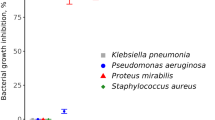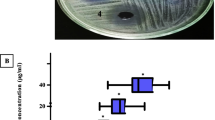Abstract
The purpose of the study is to assess the effect of a novel quorum sensing inhibitor (QSI), coded as ‘yd 47’, against otitis media and biofilm formation on Cochlear implants (CIs). Small pieces cut from cochlear implant were implanted under the skin in the retroauricular area on both sides of four guinea pigs. The implant pieces in the study and control sides were implanted in Streptococcus pneumoniae strain solution and saline, respectively. The right and left middle ears were also instilled with a solution containing pneumococci and saline, respectively. The animals were only given an intraperitoneal ‘yd 47’ twice daily for three months to be assessed later with electron microscopy. Clinical examination with palpation, inspection and otoscopy did not reveal any sign of implant infection or otitis media. In the study and control implant materials, soft tissues around the implant and tympanic membranes, there was no biofilm formation by pneumococci. Contamination by various cells and some rod-shaped bacteria (not diplococcic) were seen in some of the materials. In conclusion, the novel QSI seems promising in the prevention of otitis media and biofilm formation on CIs by pneumococci.



Similar content being viewed by others
References
Telian SA, El Kashlan HK, Arts HA (1999) Minimizing wound complications in cochlear implant surgery. Am J Otol 20:331–334
Rubinstein JT, Gantz BJ, Parkinson WS (1999) Management of cochlear implant infections. Am J Otol 20:46–49
Cunningham CD III, Slattery WH III, Luxford WM (2004) Postoperative infection in cochlear implant patients. Otolaryngol Head Neck Surg 131:109–114
Yu KC, Hegarty JL, Gantz BJ, Lalwani AK (2001) Conservative management of infections in cochlear implant recipients. Otolaryngol Head Neck Surg 125:66–70
Pawlowski KS, Wawro D, Roland PS (2005) Bacterial biofilm formation on a human cochlear implant. Otol Neurotol 26:972–975
Borriello G, Werner E, Roe F et al (2004) Oxygen limitation contributes to antibiotic tolerance of Pseudomonas aeruginosa in biofilms. Antimicrob Agents Chemother 48:2659–2664
Høiby N, Ciofu O, Johansen HK, Song ZJ, Moser C, Jensen PØ, Molin S, Givskov M, Tolker-Nielsen T, Bjarnsholt T (2011) The clinical impact of bacterial biofilms. Int J Oral Sci 3:55–65
Hoiby N (2002) New antimicrobials in the management of cystic fibrosis. J Antimicrob Chemother 49:235–238
Chen L, Wen YM (2011) The role of bacterial biofilm in persistent infections and control strategies. Int J Oral Sci 3:66–73
Miandji AM, Ulusoy S, Dündar Y, Ozgen S, Onurdağ FK, Boşgelmez-Tınaz G, Noyanalpan N (2012) Synthesis and biological activities of some 1,3-benzoxazol-2(3H)-one derivatives as anti-quorum sensing agents. Arzneimittelforschung 62(7):330–334
Miandji AM, Ulusoy S, Dündar Y, Ozgen S, Onurdağ FK, Boşgelmez-Tınaz G, Noyanalpan N (2012) Synthesis and biological activities of some 1,3-benzoxazol-2(3H)-one derivatives as anti-quorum sensing agents. Arzneimittelforschung 62(7):e2 (Supporting Information)
Costerton JW, Lewandowski Z, Caldwell DE et al (1995) Microbial biofilms. Annu Rev Microbiol 49:711–745
Donlan RM (2001) Biofilm formation: a clinically relevant microbiological process. Clin Infect Dis 33:1387–1392
Tonnaer EL, Mylanus EA, Mulder JJ, Curfs JH (2009) Detection of bacteria in healthy middle ears during cochlear implantation. Arch Otolaryngol Head Neck Surg 135:232–237
Ward KH, Olson ME, Lam K et al (1992) Mechanism of persistent infection associated with peritoneal implants. J Med Microbiol 36:406–413
Antonelli PJ, Lee JC, Burne RA (2004) Bacterial biofilms may contribute to persistent cochlear implant infection. Otol Neurotol 25:953–957
Acknowledgments
We thank to Prof. Dr. Zekiye Suludere for scanning electron microscopic examination.
Conflict of interest
This study was supported financialy by MEDers® company (Authorized Distrubutor of MED-EL® company in Turkey). I (we) certifiy that we don’t have any interest in this company.
Author information
Authors and Affiliations
Corresponding author
Rights and permissions
About this article
Cite this article
Cevizci, R., Düzlü, M., Dündar, Y. et al. Preliminary results of a novel quorum sensing inhibitor against pneumococcal infection and biofilm formation with special interest to otitis media and cochlear implantation. Eur Arch Otorhinolaryngol 272, 1389–1393 (2015). https://doi.org/10.1007/s00405-014-2942-5
Received:
Accepted:
Published:
Issue Date:
DOI: https://doi.org/10.1007/s00405-014-2942-5




